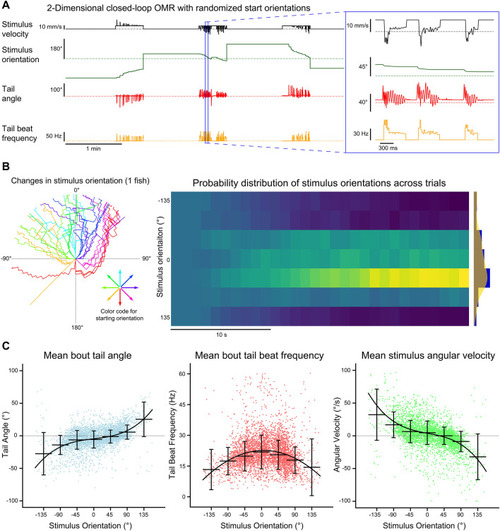
Multi-animal two-dimensional closed-loop OMR. The tails of four head-fixed fish were tracked (332 Hz) while each fish was presented with a two-dimensional closed-loop OMR stimulus. (A) Data collected for each fish included the stimulus velocity (black), stimulus orientation (green), tail angle (red) and tail beat frequency (orange). The stimulus velocity changed in proportion to the tail beat frequency and current stimulus orientation. The stimulus orientation changed with the tail angle. Trials were 30 s long and were preceded by a 1-min rest period where only the stimulus velocity and stimulus orientation data were recorded. At the end of each trial, the orientation of the stimulus was reset to one of the 8 randomized start orientations. (B) Stimulus orientation over time. Left radial plot: stimulus orientation is plotted for all trials for a single fish. Trials are color-coded based on initial starting orientation and extend outwards from the origin as a function of time. Right heatmap: normalized histograms of stimulus orientations over time across fish (n = 16). Binning was 1 s for the x-axis and 45° for the y-axis. Far right plot: histogram and kernel density estimate of the distribution of orientations at the end of trials across all fish. (C) Bout kinematics and stimulus angular velocity are plotted for each bout as a function of stimulus orientation at bout onset. Orientations were divided into 45° bins and the median and standard deviation for each bin are plotted. A polynomial function was fit to each dataset. The mean bout tail angle and mean stimulus angular velocity were fit with 3rd degree polynomials (R2 = 0.223 and R2 = 0.256, respectively) whereas the mean bout tail beat frequency was fit with a 2nd degree polynomial (R2 = 0.05).
|

